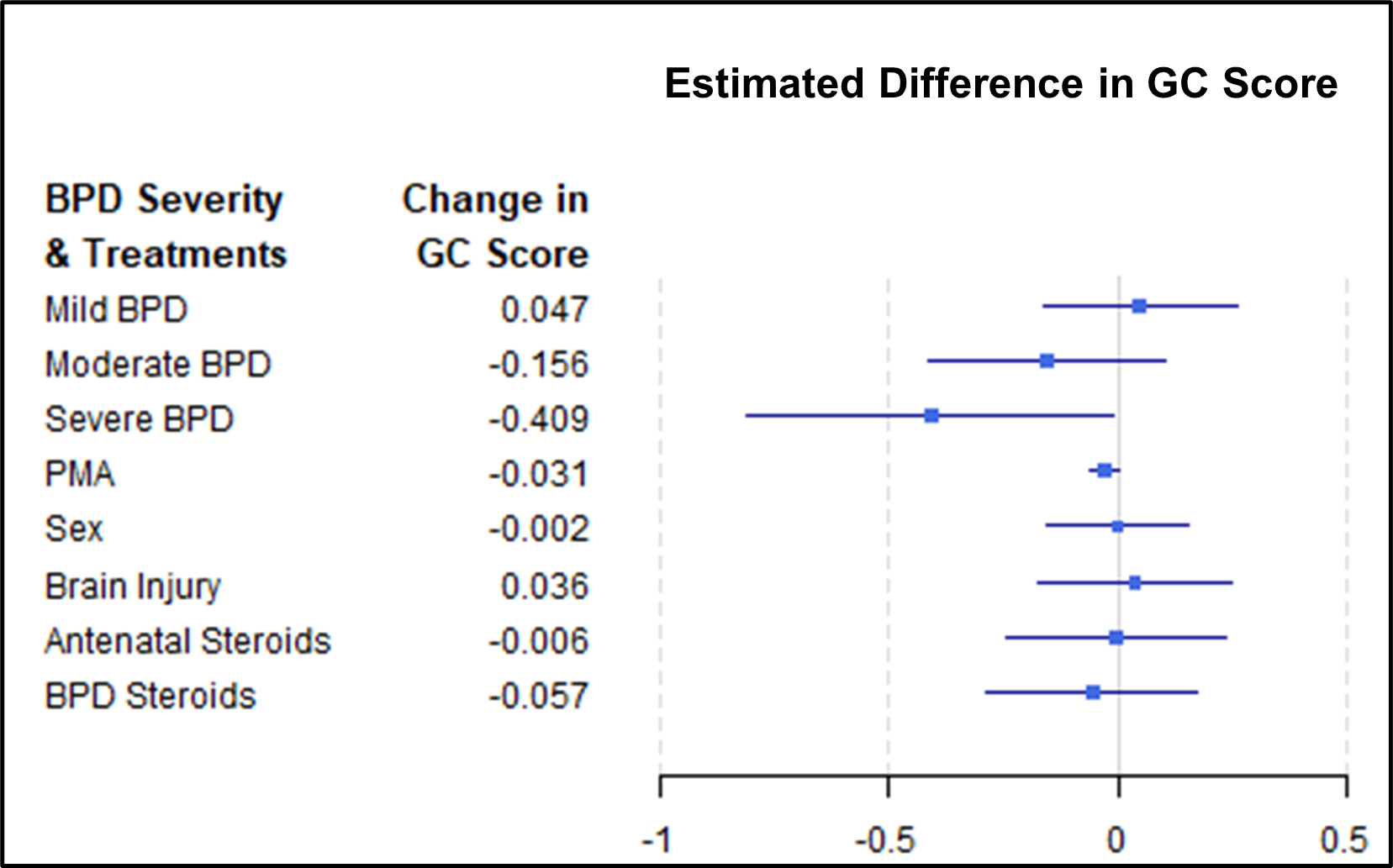Genomics/Epigenomics
Category: Abstract Submission
1: Genomics/Epigenomics I
1 - A Polyepigenetic Glucocorticoid Score is Associated with Bronchopulmonary Disease Severity
Friday, April 22, 2022
6:15 PM - 8:45 PM US MT
Poster Number: 1
Publication Number: 1.109
Publication Number: 1.109
Kenyaita M. Hodge, Emory University, Philadelphia, PA, United States; Amber Burt, Rollins School of Public Health at Emory University, Atlanta, GA, United States; Brian S. Carter, Children's Mercy Hospitals and Clinics, Kansas City, MO, United States; Jennifer Helderman, Wake Forest Baptist Health - Brenner Children's Hospital, Clemmons, NC, United States; Julie A. Hofheimer, University of North Carolina at Chapel Hill School of Medicine, Durham, NC, United States; Elisabeth McGowan, Women & Infants Hospital of Rhode Island, Providence, RI, United States; Charles R. Neal, University of Hawaii, John A. Burns School of Medicine, Kailua, HI, United States; Steven L. Pastyrnak, Helen DeVos Children's Hospital, Grand Rapids, MI, United States; Lynne Smith, Harbor-UCLA Medical Center, Torrance, CA, United States; Sheri A. DellaGrotta, Women & Infants Hospital of Rhode Island, Providence, RI, United States; Lynne Dansereau, Brown Center for Children, Providence, RI, United States; Michael O’Shea, University of North Carolina at Chapel Hill School of Medicine, Chapel Hill, NC, United States; Barry Lester, The Warren Alpert Medical School of Brown University, Providence, RI, United States; Carmen Marsit, Emory University Rollins School of Public Health, Atlanta, GA, United States; Todd M. Everson, Emory University, Atlanta, GA, United States

Kenyaita M. Hodge, MPH
Doctoral Candidate
Emory University
Philadelphia, Pennsylvania, United States
Presenting Author(s)
Background: Bronchopulmonary dysplasia (BPD), the most common morbidity among very preterm infants, is a respiratory disorder often necessitating treatment with supplemental oxygen and/or anti-inflammatory corticosteroids [e.g., glucocorticoids (GC)] to improve gas exchange. These interventions can perturb the hypothalamic-pituitary-adrenal (HPA) axis, which regulates the stress response. A polyepigenetic GC score associated with prenatal GC exposure has been developed and is associated with poor mental and behavioral outcomes – lower GC scores reflect higher GC exposure. This GC score is an innovative epigenetic biomarker for assessing early life stress and health. However, it is unknown whether the GC score from buccal samples will be associated with BPD.
Objective: To determine whether the GC score is associated with BPD and if there is a dose response with increasing BPD severity.
Design/Methods: In the Neonatal Neurobehavior and Outcomes in Very Preterm Infants (NOVI) study, buccal cell tissue was collected from 542 very preterm infants (born < 30 weeks gestational age) at Neonatal Intensive Care Unit (NICU) discharge. DNA methylation (DNAm) levels were profiled using the Infinium MethylationEPIC BeadChip. We calculated the neonatal GC score by multiplying the NOVI DNAm beta values by the 24 CpG weights established by Provençal et al (2020) and summing the values for each infant. We used generalized estimating equations (GEE) linear regression to test for differences in the GC score with increasing severity of BPD after adjusting for potential confounders, including weeks of post-menstrual age (PMA), brain injury diagnosed in the NICU, sex, study site, and steroid treatments.
Results: Increasing BPD severity was associated with the GC score in buccal tissue while adjusting for potential confounders (Figure 1). Neonatal GC score decreased with increasing BPD severity, with GC scores being significantly lower for severe BPD (β= -0.409; p-value= 0.0438).Conclusion(s): Our findings suggest that infants with more severe BPD had lower polyepigenetic GC scores, which is indicative of greater GC exposure. This decrease in GC score with increasing severity of BPD could reflect endogenous (stress related) or exogenous (treatment related) GC exposure. Future studies will investigate whether the neonatal GC score is associated with neurodevelopmental outcomes later in life.
Bronchopulmonary dysplasia (BPD) severity associated with Glucocorticoid (GC) score in buccal tissue. Multiple linear regression model for bronchopulmonary dysplasia (BPD) severity and treatment on GC score with 95% confidence intervals (CI) (0 = null on the x-axis). BPD Severity referenced to “No BPD”. Severity of BPD is significantly associated with GC score, while controlling for steroid treatment (antenatal and postnatal for BPD) and potential confounders. These results suggest that infants with more severe BPD had greater prior GC exposure.
Multiple linear regression model for bronchopulmonary dysplasia (BPD) severity and treatment on GC score with 95% confidence intervals (CI) (0 = null on the x-axis). BPD Severity referenced to “No BPD”. Severity of BPD is significantly associated with GC score, while controlling for steroid treatment (antenatal and postnatal for BPD) and potential confounders. These results suggest that infants with more severe BPD had greater prior GC exposure.
Objective: To determine whether the GC score is associated with BPD and if there is a dose response with increasing BPD severity.
Design/Methods: In the Neonatal Neurobehavior and Outcomes in Very Preterm Infants (NOVI) study, buccal cell tissue was collected from 542 very preterm infants (born < 30 weeks gestational age) at Neonatal Intensive Care Unit (NICU) discharge. DNA methylation (DNAm) levels were profiled using the Infinium MethylationEPIC BeadChip. We calculated the neonatal GC score by multiplying the NOVI DNAm beta values by the 24 CpG weights established by Provençal et al (2020) and summing the values for each infant. We used generalized estimating equations (GEE) linear regression to test for differences in the GC score with increasing severity of BPD after adjusting for potential confounders, including weeks of post-menstrual age (PMA), brain injury diagnosed in the NICU, sex, study site, and steroid treatments.
Results: Increasing BPD severity was associated with the GC score in buccal tissue while adjusting for potential confounders (Figure 1). Neonatal GC score decreased with increasing BPD severity, with GC scores being significantly lower for severe BPD (β= -0.409; p-value= 0.0438).Conclusion(s): Our findings suggest that infants with more severe BPD had lower polyepigenetic GC scores, which is indicative of greater GC exposure. This decrease in GC score with increasing severity of BPD could reflect endogenous (stress related) or exogenous (treatment related) GC exposure. Future studies will investigate whether the neonatal GC score is associated with neurodevelopmental outcomes later in life.
Bronchopulmonary dysplasia (BPD) severity associated with Glucocorticoid (GC) score in buccal tissue.
 Multiple linear regression model for bronchopulmonary dysplasia (BPD) severity and treatment on GC score with 95% confidence intervals (CI) (0 = null on the x-axis). BPD Severity referenced to “No BPD”. Severity of BPD is significantly associated with GC score, while controlling for steroid treatment (antenatal and postnatal for BPD) and potential confounders. These results suggest that infants with more severe BPD had greater prior GC exposure.
Multiple linear regression model for bronchopulmonary dysplasia (BPD) severity and treatment on GC score with 95% confidence intervals (CI) (0 = null on the x-axis). BPD Severity referenced to “No BPD”. Severity of BPD is significantly associated with GC score, while controlling for steroid treatment (antenatal and postnatal for BPD) and potential confounders. These results suggest that infants with more severe BPD had greater prior GC exposure.